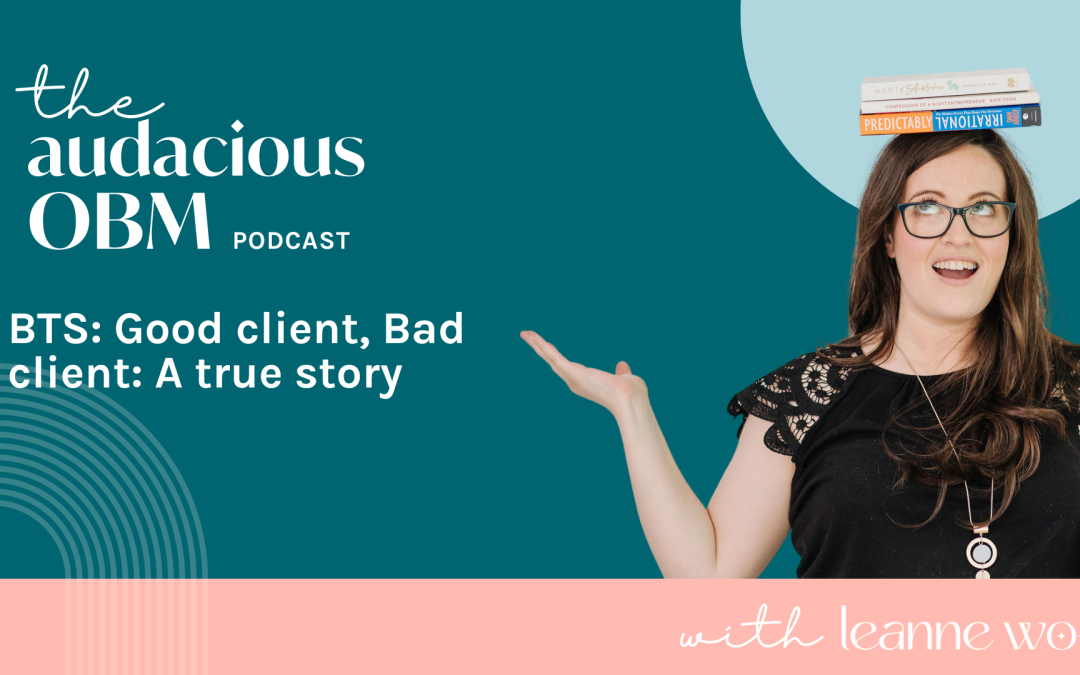As an online business manager (OBM), the relationships you build with clients can make or break your success. While some clients are a dream to work with, others can quickly turn into a nightmare, draining your energy, confidence and bank balance. In this tell-all blog post, we’ll dive into the real-life stories of two vastly different client experiences, one that was a complete disaster, and another that was an absolute joy.
By the end, you’ll have a better understanding of the key factors that distinguish a “good” client from a “bad” one, and walk away with actionable strategies to identify red flags early, set healthy boundaries, and attract your ideal customers. After all, surrounding yourself with the right clients is essential for building a thriving, sustainable OBM business. Let’s get started.
What this post covers:
-
- Unrealistic expectations and constantly changing rules can make a client relationship incredibly difficult to manage.
- Lack of communication and assumptions about processes can lead to frustration and setbacks.
- Impatience and a critical mindset from a client can quickly erode confidence and progress.
- Balancing a client’s specific needs with standardised systems is a delicate dance.
- OBMs can leverage specialised launch management training and templates to streamline their launch coordination efforts and deliver exceptional results for clients.
- Transparency and clear timelines are crucial for setting accurate expectations
- Empathy and understanding a client’s strengths and limitations can foster a harmonious partnership.
- Complementary skills and open communication are hallmarks of a successful client-OBM relationship.
- Being able to identify red flags early on can save time and prevent unnecessary heartache.
- Adapting one’s approach based on the client’s personality and preferences is key to building trust and success.
- Perseverance and a willingness to learn from challenging experiences can lead to greater resilience and discernment.
Tune in to listen:
1. Unrealistic Expectations and Constantly Changing Rules
Our first story centers around “Unrealistic Rachel” – a client who came to our OBM host via a referral, carrying a set of sky-high expectations. While the host was confident they could deliver the streamlined, sleek podcast process Rachel wanted, the relationship quickly spiralled out of control.
“This client was high strung and had no idea. The level of perfectionism and the level of just a critical approach to a lot of things was not great.“
From the outset, Rachel had conflicting rules and an inflexible approach that made the project incredibly difficult to manage. She claimed to be “easygoing” but in reality, was highly strung and critical, looking down on anyone she deemed “less successful.” The constant scope creep, impatience and resistance to building proper systems and processes was incredibly frustrating.
“Even when I was building in the pieces that were needed for it to be a systematic approach that could roll out so that other people would do it confidently, I was shot down. Every time there was an issue with every idea.”
No matter how hard the OBM worked or how much extra value they provided, it was never enough. Rachel’s unrealistic expectations and ever-changing demands meant the relationship was doomed from the start. After just four weeks, it became clear this partnership was untenable, and the host had no choice but to call it quits.
“And I was just really shocked. I’m like, it’s been a few days. Previously, I’d already told her this is the timeline. This is how long it will take. So this whole, but I’m not seeing a lot of things done. Was totally like, left to field.”
2. The Importance of Clear Communication and Aligned Expectations
This disastrous experience highlights the critical importance of clear communication and aligned expectations when working with clients. Without a shared understanding of the process, timeline and deliverables, frustration and resentment can quickly build on both sides.
As an OBM, it’s essential that you:
- Set clear, realistic timelines upfront and stick to them, rather than caving to clients’ unrealistic demands.
- Document all processes, systems and responsibilities in detail to avoid assumptions and gaps.
- Establish open communication channels where the client feels heard, but you also maintain firm boundaries.
- Identify red flags early, such as constant impatience, micromanagement or a lack of self-awareness, and be willing to walk away if the relationship is clearly misaligned.
3. Empathy and Understanding: The Keys to Harmony
Thankfully, our OBM host’s story doesn’t end there. They went on to work with a client they describe as the complete opposite of “Unrealistic Rachel”, “Light Me Up Lacey.” This experience was a complete game-changer, showcasing how a harmonious, productive client relationship can transform an OBM’s work.
“Lacey told me from the start what mattered to her in terms of this particular project and in general. And she told me what didn’t matter to her.”
From the outset, Lacey was incredibly clear about her needs, strengths and limitations. She wanted a systematic, streamlined approach to take her existing program evergreen, but acknowledged that tech and launching were not her strong suits. Crucially, she was upfront about this, creating space for the OBM’s expertise to shine.
“She trusted me and she heard what I had to say. And she let me guide her in the things I knew, and I let her guide me in the things that she knew. And the ideas that we came up with were brilliant.”
Rather than making assumptions or constantly shifting the goal posts, Lacey trusted the OBM’s guidance, provided timely feedback, and was always available for discussions. There was a genuine spirit of collaboration, with both parties playing to their strengths.
“Even if something was broken, whether it was something we built or a server issue or whatever, she still didn’t want an immediate response. She would send me emails on the weekend and say, this is for Monday, so don’t look at it.”
Importantly, Lacey didn’t project her own stress or anxieties onto the OBM, maintaining a calm, solution-focused attitude throughout the process. This created an environment where the OBM felt empowered to make decisions, try new ideas and deliver their best work.
The results speak for themselves, I was able to build a robust, scalable system that exceeded Lacey’s expectations, all while feeling appreciated, respected and trusted.
4. Adapting Your Approach to Client Personality and Preferences
This stark contrast between the two client experiences highlights a crucial lesson for OBMs: one size does not fit all. The key to building successful, long-term relationships lies in your ability to adapt your approach to each client’s unique personality, communication style and preferences.
Just as you wouldn’t use the same marketing tactics to attract a CEO and a stay-at-home parent, your client management strategies need to be customised. Some clients may thrive on constant communication and rapid responses, while others prefer more independence and space.
Pay close attention to the cues your clients give you, and be willing to adjust your processes accordingly. This could mean anything from the frequency of check-ins, to the level of detail in your reporting, to your response times for queries.
The more you can intuitively understand and align with your client’s needs, the smoother the collaboration will be. And of course, don’t be afraid to have open, honest conversations to clarify expectations on both sides.
Over to You
As our OBM host discovered, not all client relationships are created equal. While dealing with an “Unrealistic Rachel” can be soul-crushing, finding a “Light Me Up Lacey” can be incredibly rewarding, both professionally and personally.
When you surround yourself with the right clients – those who respect your time, appreciate your skills, and are genuinely committed to the partnership – your OBM business will thrive. You’ll be able to do your best work, grow your impact, and achieve the fulfillment you deserve.
So how do you go about attracting your dream clients and avoiding the Unrealistic Rachels of the world? It starts with getting crystal clear on your ideal client profile, communicating your unique value proposition with confidence, and leveraging your network to connect with the right people. But most importantly, it means having the courage to set firm boundaries and not be afraid to say “no” when a potential client just isn’t the right fit.
Are you ready to take your client relationships to the next level and build a thriving, sustainable OBM business? Tune in to the full “Good Client, Bad Client” podcast episode for even more invaluable insights and strategies. And don’t forget to check out our podcast for proven tips on attracting your ideal customers.
>> Powerfully Package Your OBM Offerings
 Now that you know top reasons for upping rates, avoid trading time for money with packaged services.
Now that you know top reasons for upping rates, avoid trading time for money with packaged services.
Check out my Powerful Service Packaging Workshop to easily create profitable packages leveraging my signature CASHUP methodology.
Pricing with purpose is possible – learn how!
BUY NOW: https://leannewoff.com/products/powerful-service-packaging-workshop/

